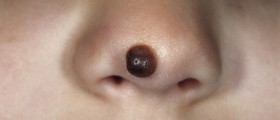When the Puberty Starts?
Puberty is defined by a series of changes that every person goes through passing from childhood into adult life. It usually lasts from two to four years.
For girls, puberty usually starts between the age of eight and 13 but it is not uncommon for it to start earlier or later than that.
Puberty starts in the brain, which sends signals to the ovaries that it is time for a change. Ovaries start producing the estrogen hormone, a chemical that induces changes in the body’s shape and size and introduces some new functions, like menstruation.
The Most Common Signs of Puberty
One of the most recognizable signs of puberty is breast growth. It starts with the nipples that become larger and darker. The breasts usually complete their development in one to four years.
During puberty the body starts making more fat in order to obtain the female form with breasts, wide hips, stomach and thighs. It can be frustrating for girls to gain weight during puberty but as long as they are not excessively overweight, this gain is normal.
Unfortunately, the changes affect the skin as well. It is now more prone to acne and blemishes, blackheads, whiteheads and red bumps. Some girls start having oily skin. All these issues can be successfully controlled with adequate skin care and beauty products. After puberty the skin will clear up.
Some parts of body may grow faster that others, like feet, hands, and ears. It can cause some girls to be more self-conscious but it is important to know that everything will even out soon.
Puberty brings changes in body hair as well. Girls start growing hair in the armpits and in the pubic area. Hair on the arms and legs becomes thicker, longer and darker as well. How this new body hair will be treated is a matter of personal choice.
Puberty and Period
Menstruation is another big event in puberty that marks the passage of a girl from childhood to the reproductive period that will last until menopause. Menstruation can start at any point during puberty although in most cases it comes after all the other changes.
Menstrual bleeding or the period, which occurs each month is the body’s way of expelling the uterus lining along with the unfertilized egg. For the first couple of times the period may be irregular. Some women have cramps when they have their period, and others do not. Also, some women have heavier PMS (premenstrual syndrome) than others. PSM includes headache, dizziness, fatigue, nausea, mood swings, and the craving of certain foods.
It is not unusual for girls to have problems with body odor during puberty. This happens because of the new hormone activities and it will stop once puberty is completed. In the meantime the body odor can be prevented and treated with proper hygiene and the use of cosmetic products like deodorants.
Finally, there will be changes in the voice, which will become stronger and deeper like in an adult as the voice box becomes larger and the vocal chords become longer and thicker.
- Our genes evolved during times when procurement of food was more difficult, leading to genetic changes which promoted thrifty genotypes and phenotypes in response to harsh times. This “developmental plasticity”, impacted by environmental exposures during sensitive developmental periods, is associated with greater obesity as well as other metabolic and physiologic consequences.
- Over the span of four decades there has been an alarming increase in childhood obesity in both industrialized and developing countries. In general, body mass index (BMI) is the most commonly used metric to classify (over)weight status, given availability of age, gender, height and weight in national datasets, as contrasted to other measures which are not typically available, such as percent body fat and waist circumference. Data from NHANES 2005-2008 reveal an estimated 17% of US children ages 2-19 years are obese (BMI >95th percentile for age and gender), compared with 6.5% during 1971-74.
- The national goal for Healthy People 2020 is to reduce the percentage of obese children and adolescents by 10%. Interventions targeting dietary and physical activity level alone have met with limited success. Comprehensive behavioral interventions combined with community level approaches have been recommended to tackle the obesity epidemic. Research on the “built” or neighborhood environment highlights the need to consider the contextual influences on childhood obesity encompassing the family, school, as well as community at large.
- Multiple studies have noted a relationship between body mass index (BMI) and timing of pubertal onset in girls. Although many of the studies examined this relationship through crosssectional analyses, for example, studies with BCERC, PROS and NHANES, several studies utilized longitudinal data.
- The observed association between obesity and early puberty leads to speculation that there may be a mechanism by which obesity directly leads to early puberty, or that obesity is part of a pathway that also leads to early puberty, with another common cause. The Frisch hypothesis suggested that menarche occurred at a critical weight (originally defined as 48kg), and that early and late maturers had similar weight at menarche.
- There are several potential mechanisms by which body fat stores might influence onset of pubertal development as well as tempo of puberty. One is through the direct action of adipokines, such as leptin, signaling energy reserves as well as having other direct metabolic effects. In addition, adipose tissue has aromatase action, which increases androgen conversion to estrogens. Adipose tissue is also related to increasing insulin resistance, which lowers sex hormone binding globulin (SHBG) levels and leads to increased bioavailability of sex steroids.


















Your thoughts on this
Loading...